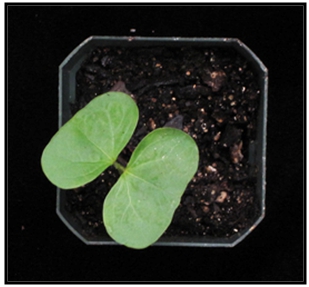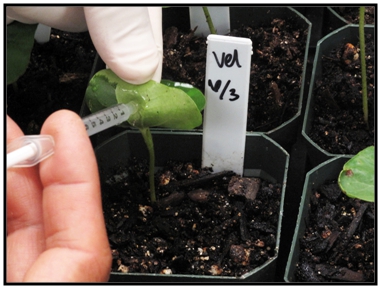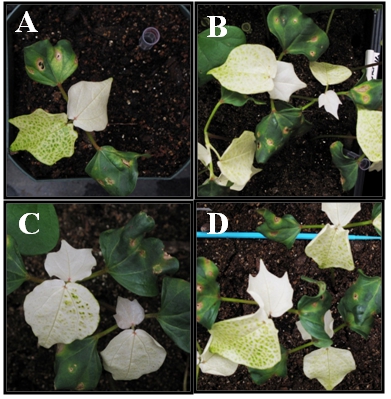A subscription to JoVE is required to view this content. Sign in or start your free trial.
Method Article
Agrobacterium-Mediated Virus-Induced Gene Silencing Assay In Cotton
In This Article
Summary
We present the detailed protocol for Agrobacterium-mediated virus-induced gene silencing (VIGS) assay in cotton. The tobacco rattle virus (TRV)-derived VIGS vectors were deployed to induce RNA silencing of cotton GrCLA1, Cloroplastos alterados 1 gene. The albino phenotype caused by silencing GrCLA1 was observed at the seedling stage within 2 weeks after inoculation.
Abstract
Cotton (Gossypium hirsutum) is one of the most important crops worldwide. Considerable efforts have been made on molecular breeding of new varieties. The large-scale gene functional analysis in cotton has been lagged behind most of the modern plant species, likely due to its large size of genome, gene duplication and polyploidy, long growth cycle and recalcitrance to genetic transformation1. To facilitate high throughput functional genetic/genomic study in cotton, we attempt to develop rapid and efficient transient assays to assess cotton gene functions.
Virus-Induced Gene Silencing (VIGS) is a powerful technique that was developed based on the host Post-Transcriptional Gene Silencing (PTGS) to repress viral proliferation2,3. Agrobacterium-mediated VIGS has been successfully applied in a wide range of dicots species such as Solanaceae, Arabidopsis and legume species, and monocots species including barley, wheat and maize, for various functional genomic studies3,4. As this rapid and efficient approach avoids plant transformation and overcomes functional redundancy, it is particularly attractive and suitable for functional genomic study in crop species like cotton not amenable for transformation.
In this study, we report the detailed protocol of Agrobacterium-mediated VIGS system in cotton. Among the several viral VIGS vectors, the tobacco rattle virus (TRV) invades a wide range of hosts and is able to spread vigorously throughout the entire plant yet produce mild symptoms on the hosts5. To monitor the silencing efficiency, GrCLA1, a homolog gene of Arabidopsis Cloroplastos alterados 1 gene (AtCLA1) in cotton, has been cloned and inserted into the VIGS binary vector pYL156. CLA1 gene is involved in chloroplast development6, and previous studies have shown that loss-of-function of AtCLA1 resulted in an albino phenotype on true leaves7, providing an excellent visual marker for silencing efficiency. At approximately two weeks post Agrobacterium infiltration, the albino phenotype started to appear on the true leaves, with 100% silencing efficiency in all replicated experiments. The silencing of endogenous gene expression was also confirmed by RT-PCR analysis. Significantly, silencing could potently occur in all the cultivars we tested, including various commercially grown varieties in Texas. This rapid and efficient Agrobacterium-mediated VIGS assay provides a very powerful tool for rapid large-scale analysis of gene functions at genome-wide level in cotton.
Protocol
1. Grow cotton seedlings
- Sow the seeds of the upland cotton (Gossypium hirsutum) variety Fibermax 832, Phytogen 425RF, Phytogen 480WR and Deltapine 90 in pots (7 cm in diameter) containing Metro Mix 700 (SunGR, Beavile, WA).
- Keep the pots in a tray covered with a plastic dome at 23°C, 120 μE m-2 S-1 light, with a 12 hour light/12 hour dark photoperiod in a growth room.
- Remove the dome when two cotyledons have emerged.
- Approximately two weeks later, use the plants with two fully expanded cotyledons for VIGS assay. At this stage, the true leaves haven't yet emerged (Figure 1).
2. Construct VIGS vector carrying GrCLA1 gene
- Amplify the Cloroplastos alterados 1 gene of cotton (GrCLA1) by PCR with primers GrCLA1-F, 5'-GCCCTTTGTGCATCTTC-3' and GrCLA1-R, 5'-CTCTAGGGGCATTGAAG-3' from a cDNA library of G. raimondii leaf tissues.
- Digest the PCR products of GrCLA1 with EcoRI and KpnI and insert into pYL156 (pTRV-RNA2) vector by ligation.
- Screen the clones on LB agar plates containing 50 μg/mL of Kanamycin. Verify the constructs by restriction enzyme digestion and sequencing.
- Transform the plasmid into Agrobacterium tumefaciens GV3101 by electroporation and recover in LB liquid medium at 28°C. Select the transformants on plates with LB+Kanamycin (50 μg/mL) + Gentamycin (25 μg/mL). The bacteria can be stored in 25% glycerol at –80°C for long term usage.
3. Perform VIGS inoculation
- Three days before inoculation, streak frozen glycerol stocks of Agrobacterium tumefaciens carrying pYL192 (TRV):RNA1, pYL156 (TRV):RNA2 (vector alone) and pYL156 (TRV):RNA2-GrCLA1 on LB agar plates containing 50 μg/mL of Kanamycin and 25 μg/mL of Gentamycin. Incubate the plates at 28°C for 24 hours.
- Two days prior to VIGS infiltration, pick a single colony for each construct from the above plates and inoculate it into 5 mL of LB medium supplemented with 50 μg/mL of Kanamycin and 25 μg/mL of Gentamycin; Grow the bacterial culture at 28°C for overnight in a roller drum at a speed of 50 rpm.
- Transfer the above culture to a flask with 50 mL of LB medium supplemented with 50 μg/mL of Kanamycin and 25 μg/mL of Gentamycin, plus 10 mM MES (2-(4 morpholino)-ethane sulfonic acid) and 20 μM acetosyringone. Grow the culture at 28°C for overnight in a shaker with a speed of 50 rpm.
- On the following day, spin down the agro-bacterial cells at 4000 rpm for 5 minutes; re-suspend the culture in the infiltration buffer containing 10 mM MgCl2, 10 mM MES and 200 μM acetosyringone. Adjust the OD 600 of the culture to 1.5.
- Leave the culture on the bench at room temperature for 3 hours.
- Prior to Agrobacterial infiltration, punch the underside of cotyledons of cotton plants with a 25 G needle without piercing through the cotyledons. One or two holes (depends on the softness of tissue) were punched on each section of cotyledon (Figure 2).
- Mix Agrobacterial culture suspension of pYL192 (TRV):RNA1 and pYL156 (TRV):RNA2 or pYL156 (TRV):RNA2-GrCLA1 in a 1:1 ratio; hand infiltrate the mixture from the underside of cotyledons through the wounding sites using a 1 mL needleless syringe (Figure 3).
- Cover the plants with a plastic dome and leave the infiltrated plants at room temperature under dim light condition for overnight.
- Transfer plants to a growth room with the temperature of 23°C, 120 μE m-2 S-1 light with a 12 hour light /12 hour dark cycle.
Note: VIGS works when plants are under either 23°C or glasshouse (25-28°C). When the temperature is relatively low (23 to 25°C), it is easier for inoculation and phenotype is more uniform compared with higher (28-30°C) or fluctuated temperature. Covering the plants with a dome also makes VIGS more efficient.
- Examine the silencing phenotype at 7~8 days post infiltration. The true leaves of silenced plants by pYL156 (TRV):RNA2-GrCLA1 started to display the albino phenotype (Figure 4). The plants infiltrated with Agrobacteria carrying pYL156 (TRV): RNA2 serve as a control.
- Verify the gene silencing efficiency by examining the expression level of endogenous genes using reverse transcription polymerase chain reaction (RT-PCR) with RNA isolated from control and silenced cotton plants.
Note: The VIGS-ed plants should be kept under contained quarantine conditions and plants should be properly autoclaved and disposed after the assays as TRV has a broad host range and is a notifiable pathogen.
4. Representative Results:
Approximately two weeks after hand-infiltration with Agrobacterial mixture, the albino phenotype caused by GrCLA1 silencing was clearly observed on the true leaves. The silencing efficiency reaches almost 100% in multiple experiments with more than 50 plants. The silenced plants display a uniformly distributed and very strong albino phenotype on newly developing leaves with a mosaic on the elder leaves (Figure 4).

Figure 1. A cotton seedling at about two-week old stage with two fully expanded cotyledons used for Agrobacterial infiltration.

Figure 2. Punching tiny holes on the underside of cotyledons of cotton plants using a 25 G needle to facilitate Agrobacterial infiltration.

Figure 3. Hand infiltration of Agrobacterial mixture into the cotyledons of cotton through the wounding sites using a needleless syringe

Figure 4. Albino phenotype appeared on VIGS silenced cotton plants. Four cultivars are shown. A) Fibermax 832; B) Phytogen 480WR; C) Phytogen 425RF; D) Deltapine 90.
Discussion
VIGS has been proven to be a powerful tool in functional genomics analysis by transiently knocking down the expression of endogenous genes. In this study, we developed an Agrobacterium-mediated VIGS by utilizing a TRV-based binary vector. The cotton CLA1 (GrCLA1) gene was developed as a visual marker to monitor the silencing efficiency. We have consistently obtained 100% of gene silencing efficiency, demonstrated by the albino phenotype appearing on the true leaves in all varieties tested, starting f...
Disclosures
No conflicts of interest declared.
Acknowledgements
We are grateful to Drs. S.P. Dinesh-Kumar and Yule Liu for TRV-VIGS vectors, and Drs. Chuck Kenerley, Terry Wheeler, Jim Starr and Bayer CropScience for providing cotton seeds. This work was funded by NSF to L.S. and NIH to P.H.
Materials
| Name | Company | Catalog Number | Comments |
| Name of the reagents and equipments | Company | Catalogue/serial number | Comments |
|---|---|---|---|
| Roller drum | Glas-Col, LLC. | 099A TC108 | Agro-bacterium culture |
| Incubator | Sheldon Manufacturing, Inc. | 01046209 | Agro-bacterium culture |
| UV/Vis spectrophotometer | Beckman Coulter | Model: DU530 | Measuring OD |
| Gene Pulser | BioRad | Model: 1652076; Serial: 154BR3880 | Electroporation |
| Pulser Controller | BioRad | Model: 1652098; Serial: 232BR4833 | Electroporation |
| Micropulser Electroporation cuvette | BioRad | 165-2081 | Electroporation |
| 1 ml Syringe | BD Biosciences | 30962 | Inoculation of agro-bacterium |
| Metro Mix 700 | SUNGR | SKU# 553001 | Growing seedling |
| Terra Cotta pot | T.O.Plastics | GPS 3001B2 | Growing seedling |
| MES monohydrate | USB | 18886 | Infiltration buffer |
| Acetosyringone | Sigma | D134406 | Infiltration buffer |
References
- Chen, Z. J., Scheffler, B. E., Dennis, E., Triplett, B. A., Zhang, T., Guo, W. Toward sequencing cotton (Gossypium) genomes. Plant Physiol. 145, 1303-1310 (2007).
- Dinesh-Kumar, S. P., Anandalakshmi, R., Marathe, R., Schiff, M., Liu, Y. Virus-induced gene silencing. Methods Mol Biol. 236, 287-294 (2003).
- Hamilton, A. J., Baulcombe, D. C. A species of small antisense RNA in posttranscriptional gene silencing in plants. Science. 286, 950-952 (1999).
- Burch-Smith, T. M., Anderson, J. C., Martin, G. B., Dinesh-Kumar, S. P. Applications and advantages of virus-induced gene silencing for gene function studies in plants. Plant J. 39, 734-746 (2004).
- Liu, Y., Schiff, M., Dinesh-Kumar, S. P. Virus-induced gene silencing in tomato. Plant J. 31, 777-786 (2002).
- Estevez, J. M., Cantero, A., Romero, C., Kawaide, H., Jimenez, L. F., Kuzuyama, T. Analysis of the expression of CLA1, a gene that encodes the 1-deoxyxylulose 5-phosphate synthase of the 2-C-methyl-D-erythritol-4-phosphate pathway in Arabidopsis. Plant Physiol. 124, 95-104 (2000).
- Mandel, M. A., Feldmann, K. A., Herrera-Estrella, L., Rocha-Sosa, M., Leon, P. CLA1, a novel gene required for chloroplast development, is highly conserved in evolution. Plant J. 9, 649-658 (1996).
- Gao, X., Wheeler, T., Li, Z., Kenerley, C., He, P., Shan, L. Silencing GhNDR1 and GhMKK2 compromised cotton resistance to Verticillium wilt. Plant J. 66, 293-305 (2011).
Reprints and Permissions
Request permission to reuse the text or figures of this JoVE article
Request PermissionExplore More Articles
This article has been published
Video Coming Soon
Copyright © 2025 MyJoVE Corporation. All rights reserved